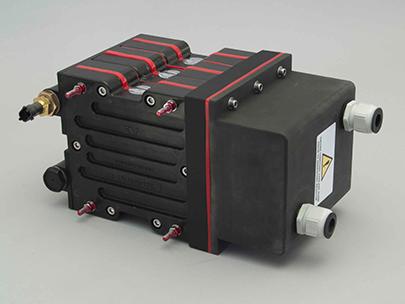
Posted to News on 2nd Nov 2022, 09:12
The role of dynamic braking resistors in the EV rollout

Simone Bruckner, managing director of dynamic braking resistor (DBR) manufacturer Cressall, explains the role of resistors in supporting the e-mobility revolution.
Developments in the electric vehicle (EV) market are advancing at a rapid pace, with consumer uptake on the increase and the end of the road for newly-manufactured ICE vehicles fast approaching. But concerns around EVs’ viability for widespread usage remain.
A DBR is a vital component in the EV power chain, responsible for safeguarding the electrical system by removing excess energy from a vehicle’s braking system. This mechanism supports several applications in the EV space – regenerative braking, fuel cell power reliability and heavy goods vehicle emergency braking systems.
In EVs, a DBR’s ability to absorb and redirect energy facilitates regenerative braking. Regenerative braking uses the excess kinetic energy to recharge an EV’s battery. It is able to do this because the electric motor in an EV can run in two directions: one, using the electrical energy, to drive the wheels and move the car, and the other, using the excess kinetic energy, to recharge the battery.
When the driver lifts their foot off the accelerator pedal and steps on the brake, the motor starts to resist the vehicle’s motion, ‘swapping direction’, and begins putting energy back into the battery. As a result, regenerative braking uses the EV’s motor as a generator to convert lost kinetic energy into stored energy in the battery.
On average, regenerative braking is between 60 and 70 per cent efficient, which means that around two thirds of the kinetic energy lost during braking can be retained and stored in the EV battery and used later for acceleration, drastically improving the energy efficiency of the vehicle and extending battery life.
However, regenerative braking cannot act alone. A DBR is needed to make the process safe and effective. If the car battery is already full or there is a failure in the system, there’s nowhere for the excess energy to be dissipated, which risks the failure of the entire braking system. So, a DBR is installed to dissipate this excess energy unsuitable for regenerative braking and dissipate it safely as heat.
In water-cooled resistors, this heat heats water, which can then be put to use elsewhere in the vehicle to provide heat to the cabin of the vehicle or preheat the battery itself, since a battery’s efficiency is directly linked to its working temperature.
Heavier loads
It’s not just in general EV braking systems that DBRs are important. There’s also an added layer of their application when it comes to the braking systems of electric heavy goods vehicles (HGVs).
Electrifying HGVs is certainly more complex than standard vehicles, but it’s no less pressing. While widespread targets haven’t been set in the same way they have for the ban on fossil-fuelled cars and vans, some goals have begun to creep in. In the UK, all new HGVs sold must be zero emission by 2040, while in Austria, the target is 2035. But there’s no denying that more of these targets will appear in the not-too-distant future.
HGVs brake differently to cars, as they do not purely rely on their service brakes to slow down. Instead, they also use auxiliary or endurance braking systems, which slow the vehicle in conjunction with the service brakes. They don’t overheat as quickly on long declines and reduce the risk of brake fade or failure of the service brakes. In electric HGVs, this braking is regenerative, which minimises wear on the service brakes and adds charge and range to the battery packs.
However, if there is a failure in the system, or the battery pack’s state of charge is unable to accept the charge, this could become dangerous. Using a DBR will dissipate the excess energy as heat to improve the safety of the braking system. To pass this test, the resistor must allow the HGV to travel six kilometres at 30 kilometres per hour on a seven per cent decline with the endurance braking system active and without the service brakes overheating and failing – the current standard set by the ECE R13 Type – IIA endurance braking performance test.
A hydrogen future
However, it’s not just in braking where DBRs come into play. We must also consider how they can positively impact the growing hydrogen fuel cell EV (FCEV) market. While FCEVs aren’t as viable for an imminent widespread rollout, the technology is there, and it certainly has more long-term promise.
FCEVs are powered by proton exchange membrane fuel cells. FCEVs turn hydrogen into electricity by combining the hydrogen fuel with air and pumping it into the fuel cell. Once inside the fuel cell, this triggers a chemical reaction, resulting in the extraction of electrons from the hydrogen. These electrons then create electricity, which is stored in a small battery used to power the vehicle.
If the hydrogen used to power them is produced using electricity from renewable sources, the result is a completely carbon-free transport system. The only end products of the fuel cell reaction are electricity, water and heat, and the sole exhaust emissions are water vapour and air, making them more aligned with the EV rollout. However, they do have some operational shortfalls.
Fuel cells are unable to work under heavy loads for a long time, which presents issues when rapidly accelerating or decelerating. Studies into fuel cell function have shown that, when an FCEV begins accelerating, the fuel cell’s power output increases gradually to a point, but then it begins to oscillate and drop despite velocity remaining consistent. This unreliable power output presents a challenge for automakers.
The solution is to install a fuel cell for a higher power requirement than necessary. For example, if a FCEV needs 100 kilowatts (kW) of power, installing a 120-kW fuel cell would ensure there is always at least the required 100 kW of power available, even if the fuel cell’s power output drops. Opting for this solution requires a DBR to remove the excess energy when not required, by performing a “load bank” function.
By absorbing the excess energy, DBRs protect an FCEV’s electrical system and also enabling them to be very reactive to high power demands and accelerate and decelerate rapidly without storing excess energy in a battery.
To meet each of these applications for DBRs in the EV space, Cressall’s EV2 DBR offers a tailored solution. When selecting a DBR for an EV application, automakers must consider a few key design factors. For all vehicles powered by electricity – be it a battery or a fuel cell – making components as lightweight and compact as possible is a top design demand.
In response to these demands, Cressall’s EV2 is a most compact and lightweight solution for the EV market, offering ten kW of power per cubic decimetre (dm3) and 9.3 kW of power per kilogram. It’s a modular solution, meaning up to five unit can be combined in a single assembly to meet power requirements of up to 125 kW.
Being water cooled, heat can be dissipated safely without the need for extra components, such as fans, as is the case with air-cooled resistors. This means that the EV2 is ten per cent of the volume and 15 per cent of the weight of a conventional DBR, lightening the load of the vehicle itself, meaning it can travel further on the same amount of fuel.
While DBRs are an essential element of an EV braking system, selecting the right one is essential to efficient operations. Offering unrivalled compact, lightweight qualities, the EV2 Cressall allows automakers to meet their design and safety requirements without forfeiting weight or size qualities.






